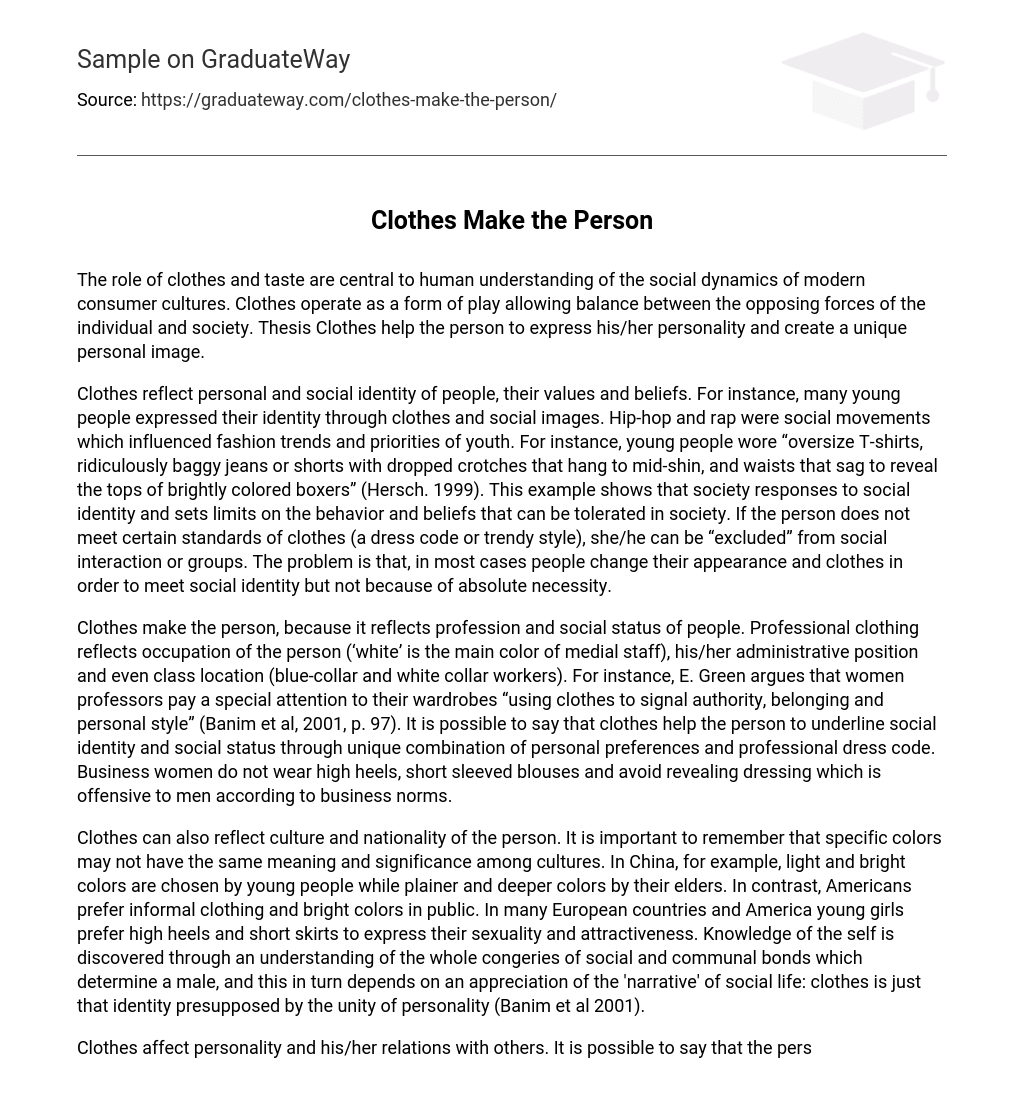The role of clothes and taste are central to human understanding of the social dynamics of modern consumer cultures. Clothes operate as a form of play allowing balance between the opposing forces of the individual and society. Thesis Clothes help the person to express his/her personality and create a unique personal image.
Clothes reflect personal and social identity of people, their values and beliefs. For instance, many young people expressed their identity through clothes and social images. Hip-hop and rap were social movements which influenced fashion trends and priorities of youth. For instance, young people wore “oversize T-shirts, ridiculously baggy jeans or shorts with dropped crotches that hang to mid-shin, and waists that sag to reveal the tops of brightly colored boxers” (Hersch. 1999). This example shows that society responses to social identity and sets limits on the behavior and beliefs that can be tolerated in society. If the person does not meet certain standards of clothes (a dress code or trendy style), she/he can be “excluded” from social interaction or groups. The problem is that, in most cases people change their appearance and clothes in order to meet social identity but not because of absolute necessity.
Clothes make the person, because it reflects profession and social status of people. Professional clothing reflects occupation of the person (‘white’ is the main color of medial staff), his/her administrative position and even class location (blue-collar and white collar workers). For instance, E. Green argues that women professors pay a special attention to their wardrobes “using clothes to signal authority, belonging and personal style” (Banim et al, 2001, p. 97). It is possible to say that clothes help the person to underline social identity and social status through unique combination of personal preferences and professional dress code. Business women do not wear high heels, short sleeved blouses and avoid revealing dressing which is offensive to men according to business norms.
Clothes can also reflect culture and nationality of the person. It is important to remember that specific colors may not have the same meaning and significance among cultures. In China, for example, light and bright colors are chosen by young people while plainer and deeper colors by their elders. In contrast, Americans prefer informal clothing and bright colors in public. In many European countries and America young girls prefer high heels and short skirts to express their sexuality and attractiveness. Knowledge of the self is discovered through an understanding of the whole congeries of social and communal bonds which determine a male, and this in turn depends on an appreciation of the ‘narrative’ of social life: clothes is just that identity presupposed by the unity of personality (Banim et al 2001).
Clothes affect personality and his/her relations with others. It is possible to say that the person communicates with others through his clothes and appearance. Neat and clean clothes suggest that the person is tidy while shabby and casual clothes create a negative image of the owner and his habits. In this case, clothes and style can be seen as non-verbal communication means which reflect psychological peculiarities and personality of the owner. I prefer to wear simple but trendy clothes which reflect my personal style and character. My relatives and friends like my style and clothes, but when I buy something special they are always surprised and amazed by small changes in my wardrobe. They expect some changes in my behavior or mood when I wear too bight or dark colors.
In sum, clothes help the person to identify himself/herself and reflect the uniqueness of his/her personality. In the current era, clothes represent one of these standards: social identify and fashion. Such a common set of meanings derives not only from the language of clothes, but refers more broadly to the pattern of beliefs, codes, and feelings on the basis of which people learn to live with their environment.
References
Banim, M., Green, E., Guy, A. Through the Wardrobe: Women’s Relationships with Their Clothes. Berg, 2001.
Hersch Patricia. A Tribe Apart. Ballantine Books, 1999.





